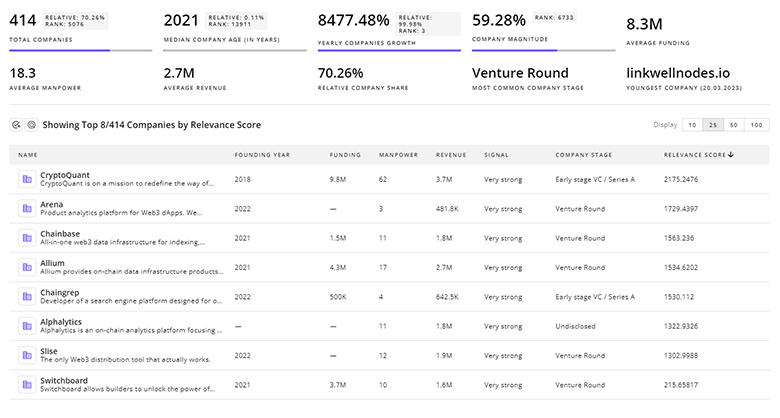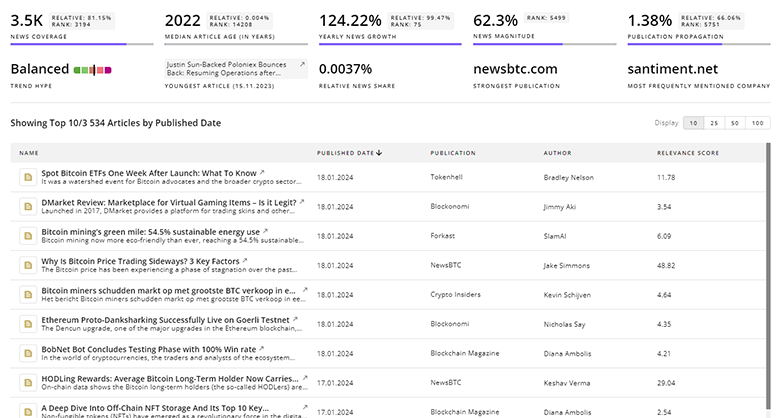
Cloud Computing Report
: Analysis on the Market, Trends, and TechnologiesThe cloud market shows sustained scale and structural change: the internal trend data records a 2024 market size of $735.45 billion and a 15.5% CAGR that underpins a projection to $1.48 trillion by 2029, indicating continued rapid expansion of demand for managed compute, data and platform services. External market studies corroborate strong multi-year growth driven by AI workloads, edge deployments and hybrid strategies, with independent forecasts ranging into the high hundreds of billions to multiple trillions by 2030 grandviewresearch.com mordorintelligence.com. These dynamics create three practical imperatives for enterprises: allocate budget to AI/accelerated workloads, govern multi/hybrid footprints to control the rising OPEX, and place latency-sensitive functions at the edge.
We updated this report 20 days ago. Noticed something’s off? Let’s make it right together — reach out!
Topic Dominance Index of Cloud Computing
The Topic Dominance Index trendline combines the share of voice distributions of Cloud Computing from 3 data sources: published articles, founded companies, and global search
Key Activities and Applications
- Migration and modernization of legacy enterprise systems to cloud-native architectures (SaaS, PaaS, IaaS) to reduce capital expense and accelerate feature delivery.
So what: companies that convert monolithic systems to cloud-native stacks free engineering capacity and shorten time to deploy AI-enabled business features. - AI/ML training and inference on GPU and HPC cloud instances for model development, simulation and analytics.
So what: demand for GPU and HPC on-demand drives specialized providers and raises pressure on cost management and sustainability. - Edge and distributed cloud deployments to host latency-sensitive workloads (IoT telemetry, AR/VR, real-time control) closer to users and devices.
So what: placing compute at the edge reduces round-trip latency and enables new real-time services that public central clouds cannot support alone. - Serverless and FaaS for event-driven microservices and rapid feature rollout.
So what: serverless reduces operational overhead for variable workloads but requires rigorous cost governance as invocation volumes grow. - FinOps, cloud cost optimization and automated governance to eliminate unproductive spend and map consumption to business outcomes.
So what: with reported cloud-spend waste material (see Emergent Trends), organizations must embed financial controls into provisioning and CI/CD pipelines. - Security, compliance and sovereign cloud initiatives to meet regulatory and data-residency requirements for sensitive workloads.
So what: providers that offer verifiable data locality and integrated compliance controls will win regulated enterprise contracts.
Emergent Trends and Core Insights
- AI-first workloads increase specialized infrastructure demand. Flexera reports a rapid rise in AI/ML cloud workloads and cloud spend; enterprises reported growing AI usage year over year flexera.com.
So what: procurement strategies must prioritize GPU access (on demand or private), cost allocation per model, and governance for model provenance. - Multi-cloud as default architecture. Survey data shows near-universal multi-cloud adoption, which drives demand for unified control planes and portability tooling.
So what: IT teams must invest in abstraction layers, CI/CD portability, and cloud-aware security to avoid vendor lock-in and manage complexity. - Edge and distributed cloud expansion. Research notes fast growth and strong CAGR for distributed cloud, reflecting real-time application needs and sovereignty concerns bccresearch.com.
So what: firms in media, gaming, telecoms and industrial automation gain competitive advantage by integrating edge zones into their architectures. - Cost leakage forces FinOps maturity. External survey data flags substantial waste in cloud budgets and rapid YoY spend growth, driving FinOps tooling adoption.
So what: establishing showback/chargeback, automated rightsizing and AI-driven anomaly detection reduces wasted OPEX and improves forecasting. - Security, zero-trust and CNAPP adoption. Rising threats and shared tenancy risks push cloud security further left into pipelines and platform controls.
So what: security needs to be embedded in IaC, container images and run time with continuous verification to meet enterprise compliance. - Sustainability and energy efficiency influence procurement. Energy-aware scheduling and greener data center design (immersion cooling, renewables) appear in innovation roadmaps and vendor messaging.
So what: sustainability metrics will become contract differentiators for large customers with ESG targets.
Technologies and Methodologies
- Kubernetes and container orchestration for portable, scalable microservice platforms.
Significance: Kubernetes enables workload mobility across public, private and edge zones but requires investment in lifecycle tooling. - Infrastructure as Code (Terraform, Ansible) and GitOps for repeatable, auditable provisioning.
Significance: IaC reduces drift and supports compliance automation across hybrid estates. - Serverless (FaaS) and event-driven platforms for bursty, short-lived processing.
Significance: serverless lowers ops burden but increases the need for observability around cost per invocation. - AI/ML for operational automation (predictive scaling, anomaly detection, FinOps) and cloud management.
Significance: applying ML to operations reduces manual toil and improves cost/performance tradeoffs for dynamic workloads. - Edge orchestration and distributed cloud frameworks that unify central and local compute.
Significance: orchestration across edge sites creates new service classes (real-time analytics, XR) and complicates security and data logistics. - CNAPPs, CSPM and Zero Trust for platform-level security across clouds.
Significance: integrating posture management into CI/CD reduces breach windows and audit overhead.
Cloud Computing Funding
A total of 20.0K Cloud Computing companies have received funding.
Overall, Cloud Computing companies have raised $1.2T.
Companies within the Cloud Computing domain have secured capital from 75.6K funding rounds.
The chart shows the funding trendline of Cloud Computing companies over the last 5 years
Cloud Computing Companies
- Zhixing Cloud — Zhixing Cloud operates a GPU computing platform offering elastic GPU deployment for AI, rendering and HPC. The company emphasizes low-cost access to high-performance GPU clusters and supports research and enterprise AI projects, positioning itself to service AI training and inference needs in markets with strong demand for domestic GPU capacity.
- Cloudalize — Cloudalize delivers a full-stack GPU-powered virtual private cloud tailored to AI and 3D/CGI workloads. The platform focuses on performance-utilization balancing and offers customizable private-cloud hosting options, making it suitable for enterprises that require tightly controlled GPU environments for rendering or model training.
- CUDOS — CUDOS provides a decentralized, blockchain-based cloud that lets users rent GPU capacity via a permissionless market. It targets Web3, Metaverse and HPC use cases and markets sustainability and open access as differentiators for distributed compute consumption.
- Cloudian Inc — Cloudian specializes in S3-compatible object storage for hybrid and edge deployments, offering geo-distributed architecture and strong data sovereignty controls. The company appeals to capacity-intensive workloads requiring long-term durability and on-prem/cloud integration.
- NuveStack — NuveStack packages cloud IT as a subscription for SMBs, bundling security, compliance and managed desktop services. The offering reduces the operational burden for regulated small enterprises and provides a turnkey path to cloud adoption with strong emphasis on secure managed services.
Gain a better understanding of 191.9K companies that drive Cloud Computing, how mature and well-funded these companies are.

191.9K Cloud Computing Companies
Discover Cloud Computing Companies, their Funding, Manpower, Revenues, Stages, and much more
Cloud Computing Investors
Gain insights into 46.2K Cloud Computing investors and investment deals. TrendFeedr’s investors tool presents an overview of investment trends and activities, helping create better investment strategies and partnerships.

46.2K Cloud Computing Investors
Discover Cloud Computing Investors, Funding Rounds, Invested Amounts, and Funding Growth
Cloud Computing News
Gain a competitive advantage with access to 210.3K Cloud Computing articles with TrendFeedr's News feature. The tool offers an extensive database of articles covering recent trends and past events in Cloud Computing. This enables innovators and market leaders to make well-informed fact-based decisions.

210.3K Cloud Computing News Articles
Discover Latest Cloud Computing Articles, News Magnitude, Publication Propagation, Yearly Growth, and Strongest Publications
Executive Summary
Cloud computing will continue to scale in volume and complexity; the commercial battleground moves from raw compute to integrated platform services that combine AI acceleration, cost governance, security and edge distribution. Practically, businesses must (1) map workloads by latency, data-sovereignty and GPU needs, (2) adopt FinOps and automated governance to reclaim wasted spend, and (3) choose partners that offer unified control across public, private and edge zones while providing verifiable compliance. Providers that assemble predictable cost models, transparent security guarantees and localized low-latency infrastructure will command premium enterprise relationships as the market matures.
We seek partnerships with industry experts to deliver actionable insights into trends and tech. Interested? Let us know!










